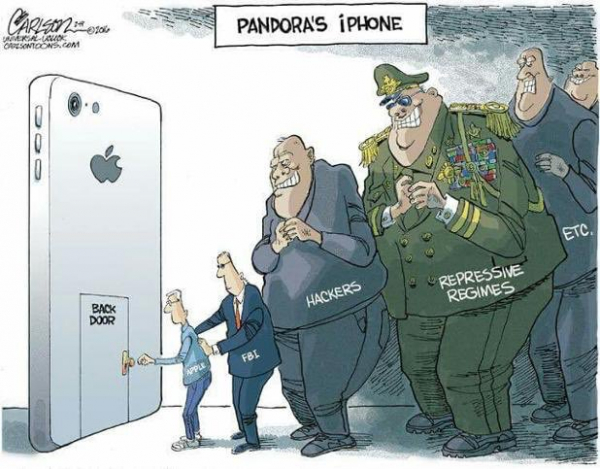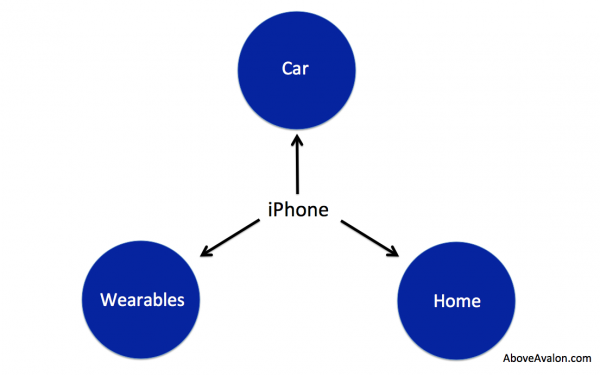One of the barbs most frequently hurled at Apple by its critics is that no new Apple product — whether it be Apple Music or Apple Watch or the iPad Pro, etc. — is, or has any chance of being, as big as the iPhone.
No [shit] Sherlock.
Of COURSE no new product is going to be as big as the iPhone — because there is NOTHING BIGGER THAN THE IPHONE. And that’s the point.
The iPhone dominates the most dominant tech sector of our time.
You can’t have it both ways. You can’t criticize Apple for not surpassing the profits of the iPhone without acknowledging the profits of the iPhone or the fact that no one has been able to surpass the success of the iPhone.
Saying that Apple’s success is “limited” to the iPhone is like saying:
- Henry Ford’s success was “limited” to cars
- John D. Rockefeller ‘s success was “limited” to oil
- Andrew Carnegie’s success was “limited” to steel
- Cornelius Vanderbilt’s success was “limited” to railroads
Being limited to a product with limitless potential, ain’t such a bad thing and if you have to be dependent upon something, it’s best to be dependent upon the most dependably profitable product of your time. [Emphasis mine]
Kids React to Windows 95 →
Tomorrow's workforce is today's kids who grew up on smartphones and tablets as their primary computers.
When these kids grow up, a "real computer" to them will not be a traditional laptop with disc drives, removable batteries, or user-upgradeable RAM/storage. Tomorrow's "real computer" will be more like today's Microsoft Surface, iPad Pro, or controversial MacBook.
Today's smartphones still have headphone jacks. The next iPhone reportedly will not.
Some will look at it as a step backwards. Apple sees it as a step forward.

iOS: The Enterprise OS of the Millennial Generation →
This younger generation does use PCs. However, they actually spend the most time on their iPhones and iPads and Macs are mostly relegated to serious productivity projects. More importantly, they know iOS inside and out as they spend much more of their day in this operating system then they do on any computer they have. I believe Apple understands this better than anyone and their most recent iPad Pro is a nod to this trend. More importantly, I see Apple using this to drive millennials towards making iOS their OS of choice as they move into their careers and new jobs. In fact, within 5-7 years, I suspect Windows will not even be of interest to this younger set, as iOS will be the device operating system that dominates their work and personal lifestyles.
Apple playing the long game.

The New Apple Era →
The iPhone, iPad, and Mac are converging into one central "brain" while new platforms will be formed focused on key aspects of our lives including transportation, home, and body (wearables). In this new era, the iPhone is positioned as the center point of our digital lives with iCloud and Apple services representing the glue connecting everything together. […]
Neil believes, as do I, the iPhone will eventually fade away and the Apple Watch will become the real personal computer.
In the future, the iPhone may melt away, and a range of devices will be able to provide an unimaginable level of personal technology. Apple Watch will likely be able to stand on its own in due time. As the definition of work changes, more and more will be designated for the wrist, further strengthening the appeal of wearables. Transportation and the connected home will be looked at as providing the same kind of personal experience.
Apple Watch is the new white earphones →
Now that I've had my watch for a few weeks, I definitely notice what people are wearing on their wrists. Maybe because I live in the Bay Area, with a lot of tech savvy people, I'm starting to see more people with Apple Watches on their wrists. [...]
The Apple Watch seems to be the iPod of this generation. When the iPod first came out in 2001, people were quick to criticize it. [...]
Soon enough, iPods were the gadget to have. People were sporting the iconic white headphones. An entire ad campaign centered around those ear buds. But in the early days, it was common to give a nod to others with the white ear buds since you knew they had an iPod as well. It's pretty crazy to think that before the iPod, no one else made white ear buds; all you had was standard black.
This reminds of the months leading up to my first iPod, my first Apple product ever. I remember walking around my college campus and just noticing everywhere, people wearing white earphones.
I started out noticing just 4-5 per day. And slowly, over time, I'd notice 4-5 an hour. On students leaving the dorms. On guys waiting for the campus shuttle. On people working out at the gym or eating alone. I distinctly remember those iconic white earphones appearing in the Winter Olympics, on NBA players warming up before marquee games, and the cult classic teen drama, The OC.
Nowadays, it's the Apple Watch that I'm noticing everywhere. On people at fast food restaurants. On shoppers at the mall. On tourists walking the Vegas strip.
And with social media, it's even easier to notice the Apple Watch on celebrities and politicians. Off the top of my head, there's been: Jay Leno, J.J Abrams, Kevin Durant, Santana, Bloomberg anchors, Larry King, Jeb Bush, and the Russian Prime Minister.
Sure, we're still early in the adoption cycle and more and more competing watches are coming onto the scene. But only one comes in that iconic rounded rectangle that is just so easy to spot from a distance.
This is how brand awareness begins.
Reducing Friction: The Difference Between Good and Great Design →
And that’s part of the reason why Apple’s “me too”s end up feeling like “me-first”s. In the age of digital, execution is staggeringly important, and there isn’t a single company in existence that can pull off polish and simplicity like Apple. While other companies struggle just to get all of their devices and services talking to one another, Tim Cook and friends are worrying over the details that actually make consumers pay attention. The products don’t just work the way they should; they feel the way they should. Reducing friction, even a single click, can change the way a user perceives an entire product. […] [Emphasis mine]
That’s partly Apple’s magic show: being able to blend the familiar, the known, and the obvious with something (even a little bit) totally new. The company’s senior vice-president of marketing, Phil Schiller, told Businessweek “You can’t just say, ‘Here it is. It does the same thing 5 percent better than last year.’ Nobody cares.” But that five per cent is often the difference between making something that people talk about, and making something they forget. That five per cent is where Apple lives.
Apple's Ace of Spades →
Most importantly, Apple has the massive user base to push its vision of the future into reality. The App Stores and Apple Pay sit on top of more than 800 million iTunes accounts with credit information. Put simply: Apple is adding features — its vision of the future — to devices you already use. That’s a great way to ensure that the future you are building works, instead of promising something world-changing you can’t deliver on.
While the tech media and everyone else argues over which company copied which, this is the one thing that no other company in the world can duplicate.
So every time Apple decides to launch a new paradigm — whether Apple does it first or not doesn't matter — the sheer number of Apple customers instantly makes it the gold standard for the rest of the industry to beat.
The iPhone Upgrade Plan is a Game-Changer →
So why is this a big deal? Well, the reasons are fairly simple: it allows Apple to take over the primary relationship with the customer, relegating the carrier to a secondary role in relation to their device purchase. Yes, you’ll absolutely still have a direct relationship with the carrier, but it will now be exclusively around the service plan and you’ll no longer be dependent on the carrier for upgrading your device. You’ll now be able to put your carrier on autopilot while you have a much more active relationship with Apple, upgrading annually on a set schedule.
My favorite part about this is how it forces the carriers to compete. Looking forward to better reliability, customer service, and more competitively-priced service plans as the carriers bend over backwards to retain customers.
How the iPhone Can Grow in Emerging Markets →
One possible solution is for Apple to sell refurbished devices in countries like India. In the US, the shift to leasing plans such as T-Mobile’s Jump on Demand and iPhone Forever program will make people return their iPhones every time they upgrade.
If these returned iPhones are refurbished, packed and sold again by Apple in emerging countries such as India at reduced rates they would sell very well. This will have two possible solutions:
Apple would not have to develop a low-cost iPhone for emerging markets and risk possible cannibalization of the high-end.
These refurbished iPhones, sold at reduced rates, will not only help Apple boost sales significantly but will help them maintain a good experience for the end users which is very important for Apple’s business model.
While all of the carriers are moving away from subsidizing to on-demand upgrading, all of these returned iPhones at the end of each lease will have to end up somewhere.
This is something that Android or Windows will never be able to do, simply because they don't have Apple's brand strength or smartphones that maintain a high enough resale value.
For Apple, U.S. carriers, iPhone users in the U.S, and potential iPhone customers in emerging markets, this is simply a win-win-win-win.